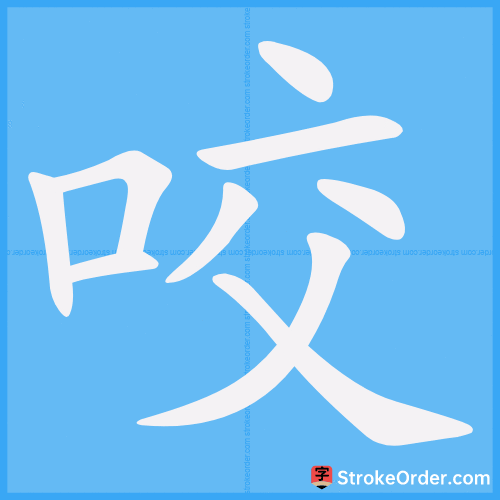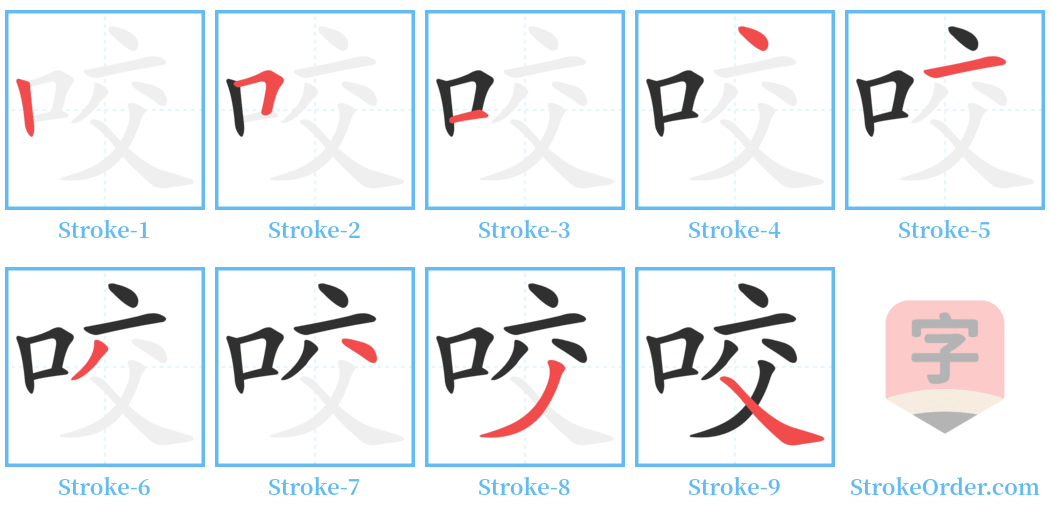咬 Stroke Order
Animated Stroke Order of 咬

Stroke Order Diagrams for 咬

Step-by-Step Handwriting Guide for 咬

Learn to Write Chinese Characters with Video Tutorials
Watch the video of writing the Chinese character "咬", learn the correct stroke order (笔顺) of the character "咬", and master the standard way of writing the character "咬".
Free Printable Handwriting Practice with Stroke Order: 咬
Printable Writing Practice Worksheet of "咬" in Portrait Orientation (Tian Zi Ge)

Printable Writing Practice Worksheet of "咬" in Landscape Orientation (Tian Zi Ge)

Information of 咬
Pinyin
yǎo
Radical
口
Strokes
9 strokes
Usage
★★★★★
Definition
bite / nip
咬
yǎo
动
【本义】: 用牙齿把东西夹住或切断弄碎
[Primary Meaning]: To use teeth to clamp or cut something.
【造字法】: 形声。从口,交声。《说文》本从“齿”。
[Character Formation]: Phono-semantic compound; composed of "mouth" (口) and a sound component. Originally from "teeth" (齿) according to Shuowen Jiezi.
1. 同本义 ([En.] snap at; bite)
- Examples: 咬啮; 咬噬; 咬紧牙关.
2. 吐字发音 ([En.] articulate; pronounce)
- Examples: 咬舌子 (to speak unclearly); 咬字不准 (to mispronounce words).
3. 比喻攀扯或诬陷他人 ([En.] incriminate sb. innocent when blamed or interrogated)
- Examples: 一口咬定 (to insist unchangeably); 乱咬好人 (to falsely accuse innocent people).
4. 螺丝等互相卡住 ([En.] bite; grip)
- Examples: 这个旧螺母咬不住扣儿 (this old nut cannot grip the fastener).
具体解释:
1. 上下牙对住,压碎或夹住东西: 咬啮、咬噬、咬紧牙关。
[Specific Explanation]: Using upper and lower teeth to crush or clamp something. Examples: to snap at, to bite, to clench one's teeth.
2. 钳子等夹住或螺丝齿轮等卡住: 咬合、咬住扣。
[Specific Explanation]: To grip something with pincers, or to become lodged, as with screws or gears. Examples: to engage, to lock in place.
3. 喻话说定了不再改变,亦指受责难或审讯时拉扯不相关的人: 一口咬定、乱咬好人。
[Metaphorical Explanation]: To insist on something that has been stated and cannot be changed; also refers to dragging in unrelated people during blame or interrogation.
4. 狗叫: 鸡叫狗咬。
[Meaning in Context]: To bark when eggs are laid; typical in idioms referring to dog barking.
5. 正确地读字音,亦指过分地计较字句的意义: 咬字儿、咬文嚼字(过分地斟酌字句,多用来讽刺死扣字眼而不领会精神实质)。
[Meaning in Context]: To pronounce characters correctly; also refers to over-analyzing the meaning of sentences.
6. 追赶进逼: 双方比分咬得很紧。
[Meaning in Context]: To steadily pursue and press on; as in a tight score in a game.
(*引自繁体辞典解释)
[Note: Imported from traditional dictionary explanations]
参见「咬咬」条。
[See also the entry for "咬咬".]
lit. to bite the teeth tightly (idiom); fig. to grit one's teeth and bear the pain / to bite the bullet
gnashing one's teeth (idiom); displaying extreme anger / fuming with rage between gritted teeth
Input Method for 咬
Pinyin
yao3
Wubi
kuqy|kury
Cangjie
ryck
Zhengma
jsoo
Four Corner
60048
Unicode
U+54ac
Same Pronunciation Characters